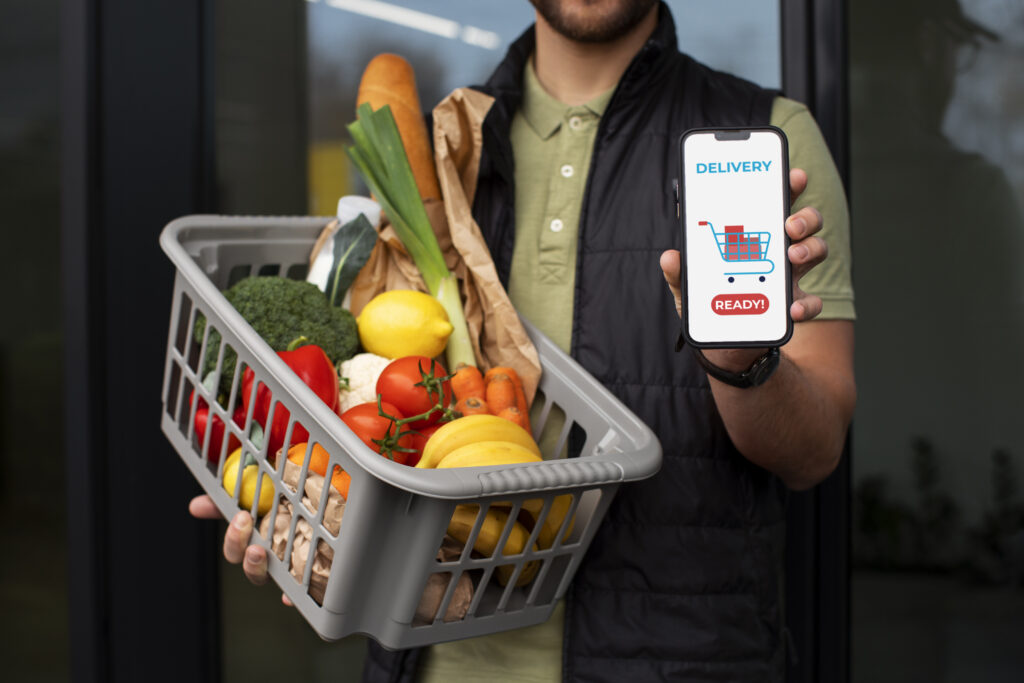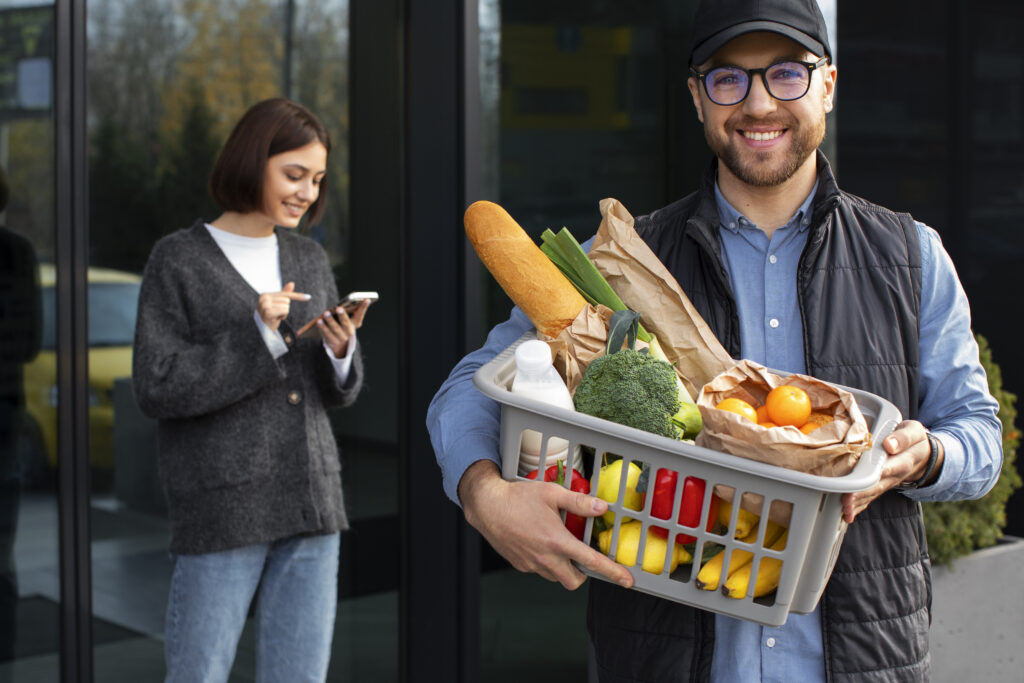In the ever-evolving landscape of retail, grocery store marketing has become an art form, blending traditional techniques with cutting-edge innovations. As consumers become increasingly discerning and tech-savvy, supermarkets must adapt their strategies to remain competitive and relevant. This comprehensive exploration will delve into the intricacies of grocery marketing, unveiling a treasure trove of supermarket advertising ideas and tactics that are reshaping the industry.

Digital Marketing Strategies:
1. Personalization Powered by AI — Know Your Shoppers’ Secrets (In a Good Way!)
Strategy: Use AI to personalize customer experiences by tracking purchase history and shopping behavior. Push customized promotions, product suggestions, and loyalty rewards directly to their phones.
Why It Works:
Customers love personalized offers, and AI can do this automatically based on shopping patterns, making them feel like you’re reading their minds.
Example:
Albertsons uses AI to create personalized offers for their shoppers, which has led to increased loyalty and engagement. AI-driven strategies like this have boosted their sales by 10%.
2. Online Grocery Shopping – Convenience Is King
Strategy: Embrace online grocery shopping with delivery and pickup options. Promote the convenience of ordering from home, either via website or app.
Why It Works:
More consumers are opting for online grocery shopping. Offering delivery or curbside pickup means customers can shop on their terms, boosting convenience and repeat business.
Example:
Walmart has seen a 15% growth in grocery sales thanks to their “Order Online, Pick Up In Store” service. It’s the perfect combination of convenience and customer satisfaction.
3. Grocery Store Apps – Your Best Digital Employee
Strategy: Create a grocery store app that offers features like real-time inventory updates, personalized discounts, and easy reorder options.
Why It Works:
An app makes grocery shopping feel more like a VIP experience. Customers get exclusive deals and find their favorite items faster, improving their loyalty.
Example:
Kroger’s app has boosted customer engagement by 30%, thanks to its personalized shopping lists and coupon integration.
4. Voice Search – Speak to Your Groceries (Seriously)
Strategy: Optimize your website and app for voice search. Let customers order groceries or find products simply by asking their smart assistants (Alexa, Siri, etc.).
Why It Works:
Consumers are increasingly using voice search to make purchases, and grocery stores should make it easy for customers to place orders hands-free.
Example:
Whole Foods (partnering with Amazon) allows customers to reorder products via Alexa, making grocery shopping even more hands-off. This has led to 50% more sales through voice commands.
5. Contactless Payments – Make the Checkout Process a Breeze
Strategy: Implement contactless payments through digital wallets or apps like Apple Pay, Google Pay, or your own store app. Offer exclusive discounts for using digital payments.
Why It Works:
Consumers love quick and easy transactions. Offering contactless payments speeds up checkout and provides an added layer of convenience.
Example:
Tesco‘s integration of contactless payments and mobile checkout has led to faster transaction times and improved customer satisfaction.
6. Social Media – Where Food Dreams Come True
Strategy: Use social media to engage customers with delicious food photos, recipes, and exclusive online promotions. Showcase new products and seasonal deals that excite your followers.
Why It Works:
Social media is a visual playground for food, and grocery stores can leverage it to create a strong brand presence and build customer loyalty.
Example:
Trader Joe’s has mastered Instagram marketing, posting seasonal specials and engaging food content, leading to a 40% boost in engagement.
7. Subscription Boxes – The Gift That Keeps Giving
Strategy: Offer grocery subscription boxes for regular deliveries of fresh produce, snacks, or pantry staples. Create themed boxes like “Family Dinner Night” or “Healthy Snacks” to appeal to different customer segments.
Why It Works:
Subscription boxes build customer loyalty by ensuring that your grocery store is always their go-to option for weekly needs, while also providing convenience.
Example:
Amazon Fresh has successfully used subscription services to create consistent, repeat orders from customers, ensuring steady revenue and customer retention.
8. Email Marketing – More Than Just Coupons
Strategy: Use targeted email campaigns to offer exclusive promotions, flash sales, and seasonal product updates. Personalize your emails based on customer preferences and past purchases.
Why It Works:
Email remains one of the most effective channels for engaging customers and driving conversions — especially when you provide offers they can’t resist.
Example:
Target has significantly increased email open rates by sending personalized weekly deals based on customers’ previous purchases.
9. Customer Loyalty Programs – Rewarding the Loyal Few
Strategy: Create or enhance your loyalty program by offering rewards, exclusive deals, or early access to promotions for frequent shoppers. Use your app or website to track and reward points.
Why It Works:
Loyalty programs incentivize repeat purchases and encourage customers to choose you over the competition.
Example:
Safeway’s “Just for U” program offers personalized digital coupons and rewards, resulting in a 35% increase in customer retention.
The Changing Face of Grocery Shopping
Gone are the days when a trip to the supermarket was a mundane chore. Today’s grocery shopping experience is a multifaceted journey, influenced by factors ranging from sustainability concerns to digital integration. As we embark on this deep dive into grocery store marketing strategies, it’s crucial to understand the shifting dynamics that are driving change in the sector.

The Digital Revolution in Grocery Aisles
One cannot discuss modern supermarket marketing without acknowledging the profound impact of digital technology. From mobile apps that offer personalised shopping lists to augmented reality experiences that bring products to life, technology is revolutionising how consumers interact with grocery stores.
- Smart shopping carts with built-in scanners
- Digital shelf labels that update prices in real-time
- AI-powered recommendation systems
- Virtual reality store tours
These innovations are not merely gimmicks; they represent a fundamental shift in grocery store advertising ideas, creating immersive experiences that blend the physical and digital realms.
Sustainability: The Green Revolution in Grocery Marketing
As environmental consciousness grows, sustainability has become a cornerstone of effective grocery store marketing tactics. Supermarkets are increasingly focusing on eco-friendly initiatives, not just as a moral imperative but as a powerful marketing tool.
Sustainable grocery marketing strategies include:
- Promoting locally sourced products
- Implementing plastic-free aisles
- Offering bulk-buy options to reduce packaging waste
- Highlighting organic and fair-trade certifications
By aligning with consumers’ values, supermarkets can build brand loyalty and differentiate themselves in a crowded marketplace.
Experiential Marketing: Turning Shopping into an Adventure
One of the most exciting trends in supermarket advertising ideas is the shift towards experiential marketing. Forward-thinking grocery stores are transforming their spaces into destinations, offering experiences that go beyond the traditional shopping trip.
Innovative experiential marketing concepts include:
- In-store cooking demonstrations and classes
- Wine and cheese tasting events
- Pop-up restaurants featuring local chefs
- Interactive product sampling stations
These initiatives not only drive foot traffic but also create memorable experiences that encourage social sharing and word-of-mouth marketing.
The Rise of Omnichannel Grocery Marketing
In today’s interconnected world, successful grocery store marketing requires a seamless omnichannel approach. Consumers expect a consistent experience whether they’re shopping in-store, online, or through a mobile app.
Essential components of a successful omnichannel approach consist of:
- Click-and-collect services
- Same-day home delivery options
- Combining digital and traditional loyalty programs
- Consistent branding across all touchpoints
By providing a frictionless shopping experience across all channels, supermarkets can meet the diverse needs of modern consumers and increase overall engagement.
The Psychology of Grocery Store Layout
While digital innovations are transforming grocery store marketing, the physical layout of the store remains a crucial element in influencing consumer behaviour. Savvy marketers understand the psychology behind store design and use it to their advantage.
Key considerations in store layout include:
- Placing essential items at the back of the store to encourage browsing
- Using end-cap displays to highlight promotions
- Implementing a clockwise flow to match natural shopping patterns
- Positioning impulse purchase items by checkout areas
By carefully crafting the in-store experience, supermarkets can guide customers through their shopping journey and maximise sales opportunities.
Embracing Health and Wellness Trends
As health consciousness continues to rise, grocery store marketing strategies are increasingly focusing on wellness-oriented offerings. From organic produce sections to in-store nutritionists, supermarkets are positioning themselves as partners in their customers’ health journeys.
Health-focused grocery marketing initiatives might include:
- Dedicated ‘free-from’ aisles for allergen-sensitive shoppers
- Nutritional labelling systems to help customers make informed choices
- Partnerships with local gyms or fitness apps
- Wellness workshops and health screenings
By aligning with consumers’ health goals, supermarkets can build trust and establish themselves as go-to destinations for wellness-minded shoppers.
The Future of Grocery Store Marketing: AI and Beyond
As we look to the future, artificial intelligence (AI) and machine learning are set to revolutionise grocery store marketing tactics. From predictive analytics that anticipate customer needs to AI-powered chatbots that provide 24/7 customer service, the possibilities are endless.
Potential AI applications in grocery marketing include:
- Dynamic pricing based on real-time demand
- Automated inventory management systems
- Voice-activated shopping assistants
- Facial recognition for personalised in-store experiences
While some of these technologies may seem like science fiction, they represent the cutting edge of supermarket advertising ideas and are likely to become commonplace in the coming years.
Conclusion: Crafting a Winning Grocery Marketing Strategy
As we’ve explored in this deep dive, the world of grocery store marketing is rich with opportunities for innovation and engagement. From leveraging digital technologies to embracing sustainability and wellness trends, supermarkets have a wealth of tools at their disposal to attract and retain customers.
The key to success lies in crafting a holistic approach that combines the best of traditional marketing wisdom with cutting-edge innovations. By understanding consumer behaviour, embracing technology, and creating meaningful experiences, grocery stores can not only survive but thrive in the competitive retail landscape.
As you develop your grocery store marketing strategies, remember that the most effective campaigns are those that resonate with your unique customer base. Whether you’re implementing sophisticated AI systems or simply rearranging your store layout, always keep the needs and preferences of your shoppers at the forefront.
In the ever-changing world of retail, one thing remains constant: the power of innovation. By staying ahead of trends and continually refining your grocery marketing approach, you can ensure that your supermarket remains a destination of choice for shoppers, both now and in the future.
🛒 FAQ: Marketing Your Grocery Store or Supermarket
1. How do grocery stores market their products?
Grocery stores market through discounts, in-store promotions, and local ads (flyers, radio). They also use social media, email, and loyalty programs to connect with customers.
2. How do I market my supermarket?
Market your supermarket by offering exclusive deals, sharing fresh product ideas on social media, and running local promotions. A loyalty program or partnering with influencers can also boost foot traffic!
3. What are the 7 steps of marketing strategy?
- Set goals
- Know your audience
- Create your message
- Pick marketing channels
- Plan your actions
- Track & adjust
- Stay consistent
4. How do I attract customers to my supermarket?
Use local ads, special discounts, and engage online (social media, website). Offer a welcoming atmosphere and run fun events to pull in customers!
